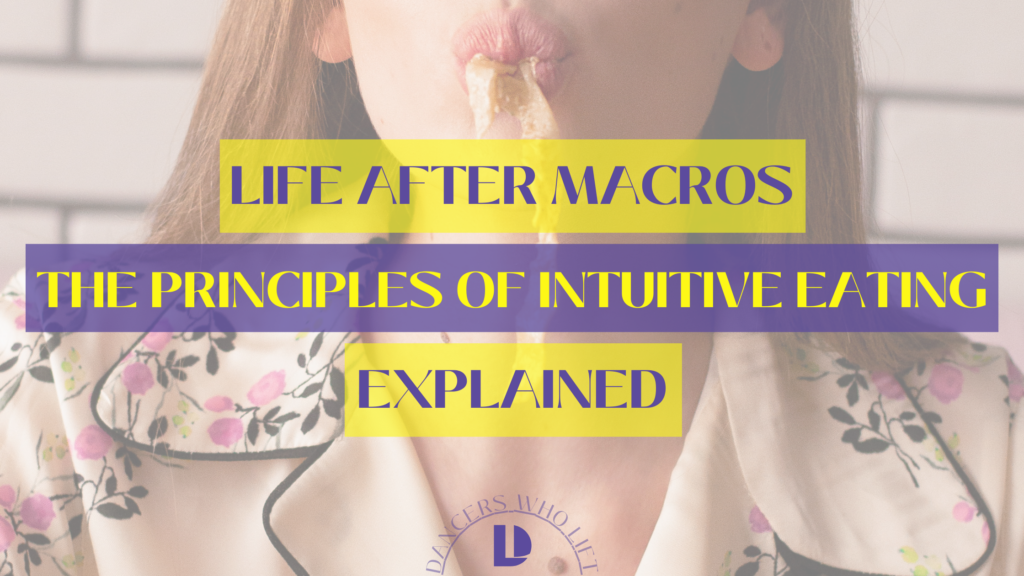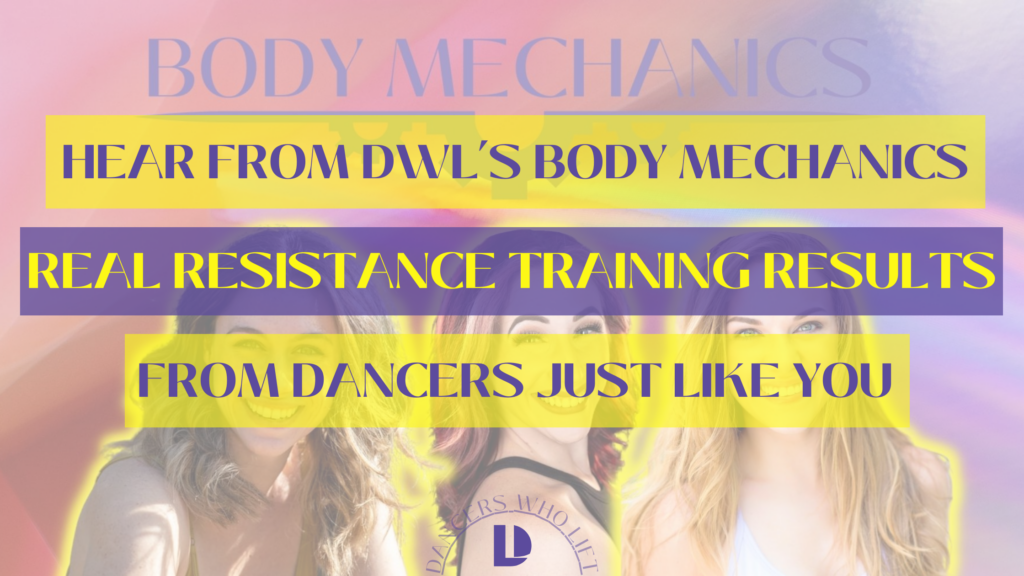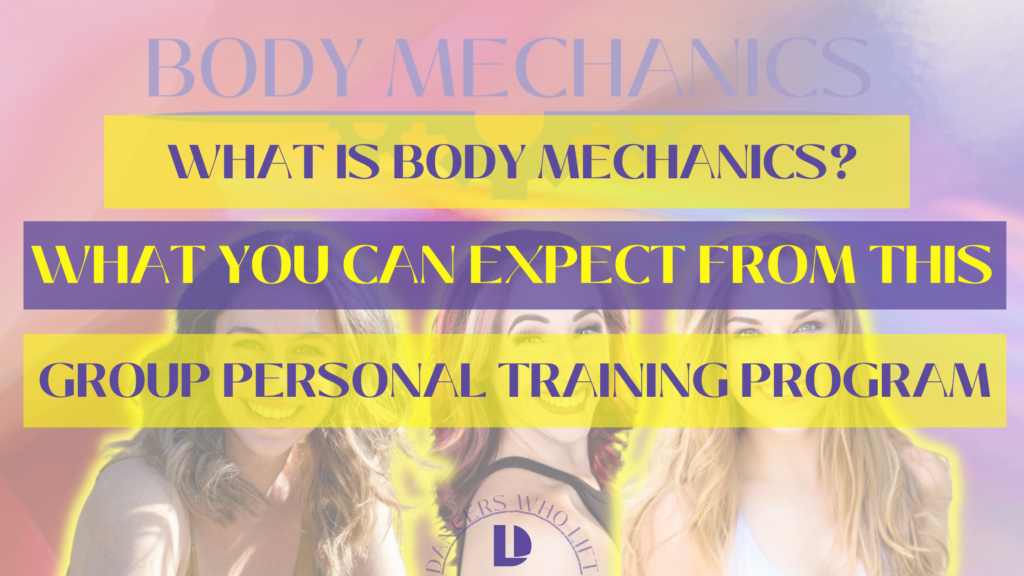The principles of intuitive eating can be challenging to undertake. Dancers Who Lift has always been committed to ensuring that dancers learn how to adequately fuel their bodies for the demanding lifestyle we lead.
We find that a lot of dancers are under-fueling themselves, which is why we always start by teaching our dancers about macronutrients and how to track them.
Both learning what your body needs and ensuring that you’re giving it what it needs is key in reaching specific physique or strength goals.
However, tracking macros in an app can be triggering for dancers and athletes who have struggled with body image in the past.
Luckily, macro tracking is not the only way to ensure you’re getting the nutrition you need!
For this, we love to recommend the perfect plate method and the hand method as a means for remaining mindful about nutrition without tracking every gram consumed.
However, for athletes that aren’t focused on specific physique goals or are in a maintenance phase, following the principles of intuitive eating can help them tune-in to the unique needs of their bodies.
Now, before you raise your eyebrows saying,
“Wait, but tracking macros is how I know I’ve hit my goals.”
Or
“If I eat intuitively I’ll only chips and salsa and pasta! That’s not optimal for anyone!”
Let me tell you that studies have shown that, overtime, eating intuitively predicts better psychological and behavioral health.
On top of that, intuitive eating is scientifically associated with lower BMI and improved dietary intake (a.k.a. Intuitive eaters chose more nutrient dense foods).
So, What Exactly Is Intuitive Eating?
Intuitive eating is the practice of letting go of tracking and tuning-in to your body and what it’s asking for.
The focus is on learning to listen to your body’s natural hunger cues – eating when physically hungry and stopping when full.
As humans we are prompted on both what and when to eat via visual, social, emotional, and even through our sense of smell.
Think about it. We eat without physical hunger cues all the time.
For example:
You show up at your local coffee shop and they’ve just pulled the baked goods out of the oven. Everything smells fresh, warm, and delicious. Suddenly, despite having had a balanced breakfast, all you can think about is eating that muffin.
Now, there are no rules. You can eat that muffin. But the principles of intuitive eating ask you to recognize why you want to eat the muffin.
This ensures that you have power and agency in choosing when and what to eat!
Another example:
It’s Saturday night and you are attending a birthday dinner at a friends house. You’re not very hungry but it is “time” for dinner and you’re literally at this person’s house for dinner. So, you sit down and eat the meal with everyone, despite not really being very hungry.
Is this bad? No!
Eating in community with others is anthropologically proven to build relationships and strengthen emotional bonds!
Besides, there are a lot of reasons (other than having eaten a lot that day) that can lead to a of appetite spanning from being a bit under the weather, where you are in your cycle, or experiencing higher than normal stress levels.
Again the principles of intuitive eating simply require you to ask yourself,
“Why am I being prompted to eat?” Before you make decisions about your food.
Okay, I’m Curious. What Are The Principles of Intuitive Eating?
Reject the diet mentality
First things first, in order to practice intuitive eating you must let go of the idea that intuitive eating is a diet. Although you may lose weight with intuitive eating, that is not the goal.
There are no calorie or macro goals in intuitive eating. Simply learning to honor your body and as a result, learn how to adequately fuel it in a sustainable way.
Honor your hunger
Eat when you are hungry. Stop when you are full. So often we push past the point of hunger because of stress, timing, or even a belief that we “shouldn’t be hungry yet.”
Learning to recognize hunger cues and respond to them is one of the most important principles of intuitive eating.
Not sure what hunger cues look like?
Check out this chart:
Make peace with food
Across the board, there is no such thing as “good” and “bad” foods.
Intuitive eating takes this principle very seriously. Eat what your body is asking for.
Will that always be the most nutrient dense choice? No.
But we eat for so many reasons beyond nutrition. Food is fuel, yes. Some fuels offer protein and high amounts of energy. Others offer comfort and pleasure.
Both forms of fuel are valuable.
Challenge the ‘food police’
This has nothing to do with others. The principles of intuitive eating are all focused on looking inwardly.
How many times have you said “Oh, I want to, but I shouldn’t eat that.”
Or, how many times have you said “I should eat this, but I want to eat this.”
Challenging the food police is all about recognizing that choosing to eat a sweet over chicken breast does not make you weak, and it does not mean you’ve thrown off your entire diet.
This principle is all about removing the negative and judgmental beliefs you might hold around food choices.
By giving yourself the foods you desire, you will more easily be able to honor your feelings of fullness.
Feel your fullness
Learning when you feel full versus stuffed can be challenging – especially if you LOVE the food you’re eating.
This is even harder if you’ve built a scarcity mindset around that favorite food.
Studies show that restricting yourself from foods can actually lead you to overeat when they’re around.
Think about it, if you go on vacation to Paris you’ll likely eat all the chocolate croissants and crepes you can get your hands on because they just aren’t as good here in the USA.
When you restrict yourself from your favorite foods, you create that same type of “I-can’t-get-this-very-often” mindset.
So, once you’ve built this trust with yourself, check in periodically throughout your meal and observe how you’re feeling.
Is your tummy feeling slightly bloated? Are you feeling satisfied? Is your body giving you a cue to sit back away from the table?
Refer to Amber’s Chart for more fullness cues!
Discover the satisfaction factor
This principle of intuitive eating is all about pleasure. Take a moment to be grateful for your food, observe it’s texture, temperature, and flavor, the environment in which you’re eating.
Taking the time to enjoy and experience your meal helps us feel satisfied and satiated.
Cope with your emotions
Remember when I said intuitive eating was all about learning why you’re being prompted to eat?
Sometimes, if we stop and listen, we learn things like:
“Every time I get cut from an audition I feel prompted to eat. But I don’t feel that prompt when I feel good about my audition.”
From this realization you might learn that you’re eating from a place of rejection and sadness rather than a place of celebration or accomplishment.
Another example of emotional eating looks like,
“I find myself wanting comfort foods when i’ve had a fight with a love one.”
While food for comfort is real, if food becomes your coping mechanism, it’s time to get curious about that response.
Learning to cope with our stress, anxiety, rejection, and depression can help us remove food from the emotional healing.
This allows more freedom of choice when we’re craving certain meals.
Respect your body
Every body is different. If I followed a strict meal plan and lifting program for 6 weeks and you followed the same strict meal plan and lifting program for 6 weeks we’d still come out looking differently.
No matter what, your body is your body. No amount of dieting will be able to remove a rib or make your femurs grow two inches.
I know, it sounds silly! But diet culture has us believing that if we cut out this food group or do x,y,z thing, it might *appear* that we have grown 2 inches and lost two ribs!
Accepting the realities of your body brings peace to your mind. A peaceful mind means lower cortisol levels. Low cortisol levels mean less bloating, less anxiety, and better sleep.
Exercise
When it comes to exercise amidst the principles of intuitive eating it isn’t about tracking your caloric burn on your apple watch. This principle is all about striving to move your body more in search of a healthier life style.
Exercising with an intuitive mindset means paying attention to when certain moves bring you joy. Then, use that joy to continue the activity.
There are no rules except the ones we choose to impose upon ourselves!
And yes, some rules are very very good. But when it comes to how you live your life on the daily? Do what makes your body feel best.
Honor your health
This is where we start to bring in nutrition. Some people call this “gentle nutrition.”
While the principles of intuitive eating stress that you shouldn’t deny yourself of indulgences.
Honoring your health does require you to recognize that our bodies need fruits, vegetables, proteins, fats, and whole grains to function optimally.
Practicing intuitive eating with gentle nutrition might look like expanding your meals and snacks to be more nutritionally dense.
For example:
You feel a craving for salt and vinegar chips and you also recognize that you’re a little hungry.
Serve yourself some chips and look at your plate. Ask yourself, how can I make this more nutritionally dense?
Maybe you add a few carrot sticks.
Maybe you add some cheese slices.
Or maybe you make yourself a protein shake because now that you think about it, you’re experiencing some brain fog.
Honoring your health is listening to your body when it says it’s tired of eating [insert favorite food here] and actually wants something different.
But What About My Macros? Do I throw those out?
No!
At Dancers Who Lift, we believe knowledge is power!
Because you understand macros, have so much knowledge about what type of nutrition fuels your body best!
Use that knowledge to honor your health as you move through your intuitive eating journey.
Allow yourself to recognize when your body says “I need some more protein” or “I’m craving some healthy avocado fats!”
Mostly, let yourself be free of restriction on this journey and get to know your body.
You might learn that your body needs more carbohydrates when you’re ovulating.
You might learn that you’ve only eaten meals because it was the “time to eat that meal.”
But you might also learn that your body knows what you need and it’s trying to tell you, if only you would listen.
Want some more tips about how to honor your body? Give these blog posts a read: Keeping Things Cool: The Benefits of Deliberate Cold Exposure for Dancers, Training Tip Tuesday: Sleeping Positions, Full Body Thirty Minute Workout (aka perfection!)












